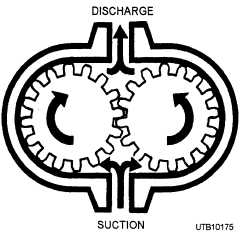types of rotary pumps are discussed-the gear pump and the screw pump.
The GEAR PUMP is shown in figure 6-10. This type of pump uses two spur gears that rotate in opposite directions and mesh together at the center of the pump. One of the gears is coupled to the prime mover (usually an electric motor) and is called the driving gear. The other gear, which receives its motion by meshing with the driving gear, is called the driven gear. Note that liquid moves as the gear teeth rotate against the casing of the pump, thereby trapping the liquid and pushing it around to the discharge outlet. The meshing together of the two gears does not in itself move or pump liquid. The meshing of the gear teeth, in effect, forms a constant seal between the suction and discharge sides of the pump and thus prevents liquid from leaking back toward the suction inlet.
Very small clearances are permitted between the meshing gears and between the gear teeth and pump casing to avoid unnecessary friction and to allow the liquid being handled to act as a lubricant for the rotating parts. It is clear that when excessive clearances are allowed to develop between the gear teeth and casing or between the gears where they mesh that the efficiency of the pump is considerably reduced. For this reason, rotary pumps are rarely, if ever, used to handle corrosive or abrasive liquids.
Of the several types of SCREW PUMPS, the main difference is the number of intermeshing screws and the pitch of the screws. Figure 6-11 shows a positive displacement, double-screw, and low-pitch pump. Screw pumps are primarily used for pumping viscous fluids, such as JP-5 and diesel oil. Hydraulic systems use the screw-type pump as the pressure supply for the system. The pump may be either motor-driven or turbine-driven.

Figure 6-10. - Gear-type rotary pump.

Figure 6-11. - Positive displacement, double-screw, low-pitch pump
In the screw pump, liquid is trapped and forced through the pump by the action of rotating screws. As the rotor turns, the liquid flows in between the threads at the outer end of each pair of screws. The threads carry the liquid along within the housing to the center of the pump where it is discharged.
OPERATION AND MAINTENANCE OF ROTARY PUMPS. - The rotary pump is susceptible to hydraulicking; therefore, the discharge stop valve must be in the OPEN position before the pump is started. In addition, it is a good operating practice to prime these pumps before operation when possible. This is particularly critical when the pump has been standing idle for a period of time. This is true in spite of the fact that rotary pumps are self-priming. Because the liquid handled in the pump lubricates the rotating elements of these pumps, filling the pump end with fluid before starting prevents unnecessary friction and wear of the rotating elements.
Rotary pump maintenance schedules stress that proper clearance be maintained between rotating parts. . For this reason, there should be periodic checks for slippage. In addition, when the pump is dismantled, the actual clearances should be carefully measured and compared with the manufacturer's specifications.
Reciprocating Pumps
A reciprocating pump moves water or other liquid by means of a plunger or piston that reciprocates (travels back and forth) inside a cylinder. Reci- procating pumps are positive displacement pumps;
Continue Reading